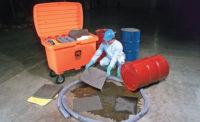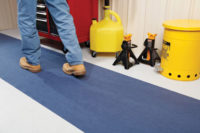When OSHA revised the walking-working surface standard in 2016, part of the goal was to make the general industry standard more consistent with existing construction standards. The rule also acknowledged advances in technology over the past 30-plus years by adding several new provisions that allow employers greater flexibility to choose from a variety of solutions to meet their fall protection and prevention needs.
Prior to 2016, the primary method for preventing falls from elevation in general industry was to install guardrails. While guardrails provide adequate protection for many situations, they didn’t work well for every application and did not reflect the availability of other equally or more appropriate fall prevention technologies that have proven to be successful for decades in other industries.
Employers are still required to identify fall hazards in their workplaces and to provide employees with protection from these hazards. The revised rule still allows the use of guardrails to prevent falls, but also now permits the use of personal fall protection systems and other methods.
Guardrails
Guardrail systems are barriers that are mounted along edges, exposed sides or in other areas with a drop of four feet or more. They must be structurally sound, of appropriate height and capable of withstanding a force of at least 200 pounds [29 CFR 1910.29(b)].
Because guardrails were specified as the primary means of fall protection in the original walking-working surface standard issued in 1971, they are, and will continue to be, a commonly-used solution to prevent falls. Guardrails can be used to help prevent falls through holes, around stairways, on platform edges and in many other areas.
Personal fall protection systems
Personal fall protection systems protect workers who need to frequently lean over edges, such as those who attach loads to hoists or those who add ingredients into large processing vats. They can also be used to protect employees who work on platforms, scaffolding, roofs and other elevated surfaces.
These systems can be used to either prevent an employee from falling off an elevated surface or to safely arrest a fall from elevation when it occurs. The three essential parts of a personal fall protection system are anchorage, body harnesses and connectors. When selecting these systems, they should be designed, installed and tested as complete systems to ensure that each component works correctly with the other two.
Employees who use personal fall protection systems must be properly trained [29 CFR 1910.30]. Employers must also ensure that they have a means of “prompt rescue” to quickly retrieve any employee who falls from an elevation [29 CFR 1910.140(c)(21)].
Travel restraint systems
A form of personal fall protection, travel restraint systems prevent employees from going over the edge of a walking-working surface. This is accomplished by the use of lanyards or lifelines that limit how far an employee can travel.
By limiting the distance that an employee can travel from an anchorage point, the possibility of unintentionally stepping or reaching over an edge is eliminated.
Covers
Covers can be used to protect holes, skylights, and stairway openings that can’t be protected by guardrails. Covers can be open cages or solid structures, but must be capable of supporting twice their intended load [29 CFR 1910.29(e)].
Limiting access/designated areas
All employees who are exposed to fall hazards must be properly trained to recognize those fall hazards, follow procedures to avoid injuries and use the correct personal protective equipment (when applicable) to prevent harm. Limiting access in areas with fall hazards to only those employees who have been properly trained prevents untrained employees from being harmed.
Another form of limiting access is the use of “designated areas.” These areas allow work to be performed on elevated surfaces without the use of fall protection devices, but are far enough from an edge to prevent an employee from falling. Designated areas must be at least six feet from an edge, physically marked with a rope, chain, wire or tape and clearly visible [29 CFR 1910.29(d)].
Safety net systems
Safety net systems are often used as a supplemental form of fall protection in areas where personal fall protection systems are not practical, such as above dangerous equipment or near chutes. Construction sites often use safety net systems in areas where there is the potential for a greater than 25-foot fall from ladders, scaffolding or platforms.
Compliant safety net systems must meet OSHA’s construction standard for safety nets, which includes installing the net as close as possible to the working surface, using appropriate fasteners and ensuring sufficient clearance below the net [29 CFR 1910.39(c) and 29 CFR 1926.105].
Signage and floor markings
The edges of service, repair and assembly pits that allow employees to perform work under an object often cannot be fitted with guardrails to prevent falls. To prevent injuries, employees who work in these areas must be properly trained and authorized [29 CFR 1910.28(b)(8)].
If others need to perform work in the general area near these pits, floors must be marked at least six feet from the edge with a contrasting color or warning line. Stanchions or barricades and signage must also be used to alert employees to the presence of open pits.
Ladder safety systems
Ladder safety systems are designed to reduce or eliminate the possibility of falling from a ladder while allowing the employee to use both hands to climb or descend the ladder. Ladder safety systems or personal fall arrest systems are required on all fixed ladders installed or replaced on or after November 19, 2018.
When employees reach the top of a fixed ladder or platform, grab bars can be used to provide a safe means of transitioning from a ladder onto the elevated surface or platform. They should be at least as wide as the ladder rungs and extend at least 42 inches above the elevated surface or platform [29 CFR 1910.23(d)].
Formerly, cages and wells were used to protect employees from falls on fixed ladders. However, it has been determined that cages and wells can cause employees to become tangled or caught during a fall. Because of this, ladders with cages or wells must be eliminated by November 18, 2036.
Falls from elevations are a leading cause of workplace injuries. Identifying fall hazards and utilizing one or more fall protection options to protect employees can eliminate these hazards, prevent injuries and ensure a safer work environment.



